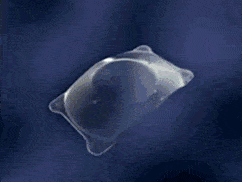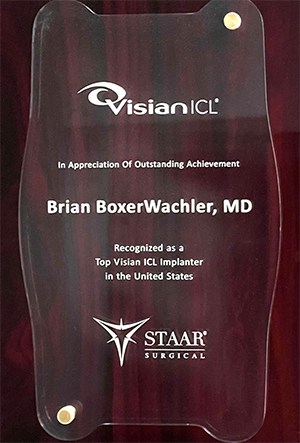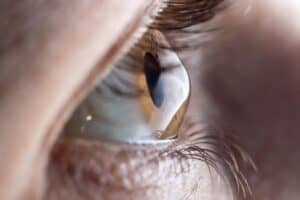1-Step Ultrasound-Guided EVO Visian ICL™
 Insertable lenses are one of the most exciting new breakthroughs in the field of enhanced vision care. After 25 years of study in Europe, insertable lenses are now approved by FDA to nearsightedness and astigmatism.
Insertable lenses are one of the most exciting new breakthroughs in the field of enhanced vision care. After 25 years of study in Europe, insertable lenses are now approved by FDA to nearsightedness and astigmatism.A significant advantage of the 1-Step Ultrasound-Guided EVO Visian ICL™ is that this is bicompatible and “in sync” with the body. The 1-Step Ultrasound-Guided EVO Visian ICL™ is removable and provides “HD Vision”. Over 500,000 procedures have been done worldwide.
The procedure is outpatient and can be typically performed in 10 minutes per eye with the goal of improvement to the patient’s vision by the very next day. 1-Step Ultrasound-Guided EVO Visian ICL™ can also be updated with a new prescription should vision change in the future. Potential benefit of 1-Step Ultrasound-Guided EVO Visian ICL™ is improved eyesight and potential risks are suboptimal vision, infection, inflammation, loss of vision among others. That is the reason that Dr. Brian and every staff member is highly “detail-oriented” about every step of the process for every patient. Dr. Brian and his team have published results in the medical literature and presented results at numerous medical conferences on 1-Step Ultrasound-Guided EVO Visian ICL™.
Musician Joe Jonas Discusses EVO Visian ICL
Dr. Brian uses a specialized ultrasound device to determine to idealized size of the EVO ICL. The EVO ICL is customized to not just each person, but each eye of each person.
If you have Keratoconus and are interested in 1-Step EVO Visian ICL™, please click here for information about 1-Step EVO Visian ICL™ for Keratoconus.
The United States military commonly uses the 1-Step Ultrasound-Guided EVO Visian ICL™ on those who serve our country. Their government-funded studies found 1-Step Ultrasound-Guided EVO Visian ICL™ provides superior vision over LASIK for higher degrees of nearsightedness.
Dr. Brian was selected by Starr Surgical, a public company that makes the 1-Step EVO Visian ICL™, to develop an exclusive 10-part webinar series to train other ophthalmologists to perform his most advanced 1-Step EVO Visian ICL™ procedure. Even afterwards, few doctors were able to incorporate all of Dr. Brian’s training pearls.
EVO Visian ICL on Good Morning America
| EVALUATIONS | POTENTIAL BENEFIT to PATIENT |
| Internal lens position | Ability to provide sharper vision than LASIK for poorer levels of eyesight (higher prescriptions stengths) |
| Stable lens | No need for maintenance. You’ll typically not feel the 1-Step EVO Visian ICL™. Material won’t degrade. |
| Patient fear of LASIK | Alleviates concerns in patients who are uncomfortable with LASIK lasers |
The Advantages of 1-Step Ultrasound-Guided EVO Visian ICL™
Quality of Vision
The 1-Step Ultrasound-Guided EVO Visian ICL™ offers high quality of vision. Two unique factors help explain this superior optical performance. First, the 1-Step Ultrasound-Guided EVO Visian ICL™ is made of Collamer – a soft, flexible lens material that contains a small amount of collagen – making the lens extremely biocompatible for a lifetime of clear vision. Second, the lens is placed inside of the eye, where it continues to focus light typically without any maintenance required.
Safety
The 1-Step Ultrasound-Guided EVO Visian ICL™ is inserted into the eye by an ophthalmologist through a small, micro incision. The lens unfolds in the eye and is positioned between the iris and the natural lens where it stays indefinitely. The procedure takes approximately 10 minutes and is performed on an outpatient basis.
Click for Important Safety Information
Advanced Lens Material
The 1-Step Ultrasound-Guided EVO Visian ICL™ is made of Collamer, an advanced lens material that has unique properties. Collamer transmits light and reduces reflections that can interfere with vision to enhance vision. Made of a copolymer and collagen, Collamer is also highly biocompatible. It allows the 1-Step Ultrasound-Guided EVO Visian ICL™ to rest quietly in position while correcting vision. Collamer is the only lens material made with collagen – a top choice for a lens that is going to remain inside your body for a lifetime.
Removable
The 1-Step Ultrasound-Guided EVO Visian ICL™ is not designed to alter any structures within the eye or on the cornea. If necessary, it can be removed from the eye.
Invisible and Undetectable
You won’t be able to see the 1-Step Ultrasound-Guided EVO Visian ICL™ in your eye, and typically neither will anybody else.
Excellent For a Wide Range of Vision Correction needs
Anyone seeking clear vision may be a candidate for the 1-Step Ultrasound-Guided EVO Visian ICL™, including patients with extreme or special vision correction needs.

| A Top EVO Visian ICL surgeon in the United States |
| Developed for an eye surgery organization the safety and sterility guidelines for performing phakic IOLs (EVO Visian ICLs) in an office-based procedure room |
| Trained thousands of eye surgeons for StaarSurgical, the maker of EVO Visian ICL, on how to perform office-based EVO Visian ICL procedures |
| Trusted by the FDA as a FDA clinical trials investigator for implantable phakic IOLs for nearsightedness |
FAQs About Implantable Contact Lenses
Exactly where is the Ultrasound-Guided 1-Step EVO Visian ICL™ placed in the eye?
1-Step Ultrasound-Guided EVO Visian ICL™ is placed in the “posterior chamber” – behind the iris (color portion of the eye) and in front of the eye’s natural lens. The lens does not touch any internal eye structures and stays in position.
Will it hurt?
We use powerful numbing drops to keep you comfortable during the procedures. There can be some slight pressure during the procedure, but overall patients say “that was easier than a visit to my dentist.”
Someone told me there are no long-term studies on 1-Step Ultrasound-Guided EVO Visian ICL™. Is that true?
The basic procedure is similar to cataract surgery with placement of an intra-ocular lens, which dates back to the 1940s. The 1-Step Ultrasound-Guided EVO Visian ICL™ procedure has been successfully performed since 1997 and was FDA approved in 2005. Over 150,000 surgeries have been performed in the United States since 2005. Over 60 years of long-term cataract lens studies and 5 year post-market FDA approval studies has showed excellent long term results. The satisfaction rate among patients is extremely high – above 99%. 1-Step Ultrasound-Guided EVO Visian ICL™ provides excellent and stable outcomes. With any procedure there is an element of risk, so it’s important to consult an eye doctor about being a candidate and discuss the details of 1-Step Ultrasound-Guided EVO Visian ICL™ for your needs. In addition, select a surgeon who has performs 1-Step Ultrasound-Guided EVO Visian ICL™ regularly is advised.
Should I wait until something else comes along?
The decision to have the procedure done is yours. If you are determined to be a good candidate, your expectation is to be happy with the results, however it is not possible to make any guarantees. If you are not comfortable, then we would not want you to have anything done.
What is 1-Step Ultrasound-Guided EVO Visian ICL™ made of?
1-Step Ultrasound-Guided EVO Visian ICL™ is made of Collamer, an advanced lens material that is highly bicompatible Collamer and does not cause a reaction inside the eye. Also, the material contains a UV filter that provides additional protection to the eye beyond sunglasses.
What if my vision changes?
In good candidates, there is typically no need to worry about ever having large vision changes. The advantage to the 1-Step Ultrasound-Guided EVO Visian ICL™ is flexibility. If your vision did happen to change, the lens can be removed and replaced with a different power or another procedure can be performed at anytime. In addition, with 1-Step Ultrasound-Guided EVO Visian ICL™ you can wear glasses or contacts lenses if your vision did change.
What is involved in the 1-Step Ultrasound-Guided EVO Visian ICL™ procedure?
The actual 1-Step Ultrasound-Guided EVO Visian ICL™ procedure typically takes approximately 10-15 minutes and is performed on an outpatient basis. Normally, very little discomfort is associated with this procedure. A very powerful topical anesthetic eye drop is instilled in the eyes to keep your eyes numb and a mild sedative is given to keep your relaxed and comfortable (no needles or IV medications are ever used). You will come back the next day after the procedure for a follow-up visit and in most cases will be able to resume driving and most activities after this follow-up visit. Eye drops and oral medications are prescribed to be used for a couple of weeks after the procedure to help with healing.
I live outside of Beverly Hills and don’t like to drive a lot. Doesn’t that make me ineligible to have the 1-Step Ultrasound-Guided EVO Visian ICL™ procedure with Dr. Brian?
Actually we have a number of patients who come from outside of Beverly Hills as well as outside the state and country. You will need to plan to be in the area for 7-8 days for preoperative exam, procedure and initial follow-up. Then it is no problem to have a qualified colleague of Dr. Brian’s assist in the after surgery follow-up care if that is more convenient. We are happy to coordinate your aftercare and assist you with local hotel accommodations if desired. You are also welcome to return to our office for follow-up care visits at 3 months and 12 months after the procedure.
Can the lenses dry out or get dirty like contact lenses?
No. Patients who get dry eyes from traditional contact lenses may be ideally suited for 1-Step Ultrasound-Guided EVO Visian ICL™ since this lens cannot be felt. 1-Step Ultrasound-Guided EVO Visian ICL™ avoids problems experienced with traditional contact lenses. It is designed to remain in place and inside your eye, without maintenance. A routine, annual visit with your eye doctor is recommended to make sure everything is fine.
Can the 1-Step Ultrasound-Guided EVO Visian ICL™ be seen by the naked eye?
No. The lens is positioned behind the iris (colored portion of the eye). This makes the lens invisible to both you and observers. You enjoy a cosmetic appearance that is natural. Only your doctor will be able to tell that vision correction has taken place.
Can the 1-Step Ultrasound-Guided EVO Visian ICL™ be felt inside my eye?
No. The lens is not noticeable after it is put in place; similar to a dental filling you don’t notice after it has settled into your teeth. It does not attach to any structures within the eye, therefore there is no pulling sensation. The lens is gently tucked behind the iris (colored portion of the eye) where it stays in position.
How long does the 1-Step Ultrasound-Guided EVO Visian ICL™ stay in my eye?
The 1-Step Ultrasound-Guided EVO Visian ICL™ is intended to remain in place without maintenance on a permanent basis. Should it become necessary, the lens can be removed by a certified ophthalmologist. At some point in life, most people regardless of having the 1-Step Ultrasound-Guided EVO Visian ICL™ or not will develop cataracts. At this point the 1-Step Ultrasound-Guided EVO Visian ICL™ lens will be removed along with your natural lens that has developed into a cataract and then a new clear lens will be inserted into the eye.
Will I have to miss weeks of work and stay in bed?
Most patients take 1-2 days off work as “medical leave”. Patients typically drive and go back to work the day after the follow-up exam the very next day after the procedure.
Do I have to give up my workouts for a few weeks?
Patients usually resume light work-outs 3 days after the procedure and strenuous work-outs 1 week after procedure. We advise refraining from swimming or water sports for 2 weeks.
What is the Success Rate for 1-Step EVO Visian ICL™?
EVO Visian ICL is inserted using a micro-incision by our highly-experienced and renowned ophthalmologist, Dr. Brian. The advanced lens material is Collamer, the only kind that contains collagen and reduces the risk of reflections. The implantable lens doesn’t alter any part of your eye, making the procedure reversible. 1-Step Ultrasound-Guided EVO Visian ICL™ offers excellent, stable outcomes with more than 99 percent satisfaction among Dr. Brian’s patients.
The EVO ICL procedure is FDA-approved for adults between the ages of 21 and 45, and EVO Visian ICL is considered safer than LASIK for some patients.
What are the Vision Parameters for EVO Visian ICL?
 The lens power of your prescription glasses and contact lenses is measured in diopters. The higher the number, the worse your vision. EVO Visian ICL is FDA-approved to correct or treat high myopia (nearsightedness) and astigmatism. Severe nearsightedness is considered -6.00 diopters and higher. EVO Visian ICL can correct high myopia from -3.00 to -16.00 diopters and reduce nearsightedness in those with -15.00 to -20.00 diopters.
The lens power of your prescription glasses and contact lenses is measured in diopters. The higher the number, the worse your vision. EVO Visian ICL is FDA-approved to correct or treat high myopia (nearsightedness) and astigmatism. Severe nearsightedness is considered -6.00 diopters and higher. EVO Visian ICL can correct high myopia from -3.00 to -16.00 diopters and reduce nearsightedness in those with -15.00 to -20.00 diopters.
In contrast, LASIK vision parameters for nearsightedness may go up to -12.00 diopters, but -8.00 or less is often seen as the ideal range. LASIK results are predictable and complication rates are lower in patients with lens power of -8.00 or less.
The implantable lens can correct for astigmatism of 2.5 diopters or less with a toric version. Dr. Brian uses an ultrasound device to identify the ideal EVO ICL size and lens power for each eye.
Can I Still Get Cataracts After EVO Visian ICL?
Yes, you may still develop cataracts later in life after EVO Visian ICL because the procedure does not alter your eye’s natural lens. A cataract forms in the lens of your eye due to clumps of protein that build up over time, causing cloudy and distorted vision. Cataracts affect most people in their golden years but are curable through cataract surgery.
However, people with high myopia are at a higher risk of developing cataracts earlier in life. Considering people with severe nearsightedness are prime candidates for EVO Visian ICL, this patient group may be more likely to experience cataracts. The formation of cataracts after EVO ICL surgery has been researched extensively. The incidence of cataracts after EVO ICL was linked to the type of EVO ICL used, degree of myopia and the patient’s age. EVO Visian ICL is made with Collamer — an advanced lens material and the only one of its kind to contain collagen for high-quality vision with a soft and flexible lens.
A 2018 study in the Canadian Journal of Ophthalmology studied complication rates among 1,653 eyes with implantable lenses and found the rates of complications were extremely low, but higher myopia and patient age increased the incidence of cataracts. However, EVO ICL benefits outweigh the risks when you consider the significant improvement of quality of life.
Can 1-Step Ultrasound-Guided EVO Visian ICL™ Improve Keratoconus?
 Yes, 1-Step Ultrasound-Guided EVO Visian ICL™ for Keratoconus is one of Dr. Brian’s specialties. He’s spent decades helping keratoconus patients improve their vision and is recognized as an expert in the area. The maker of EVO Visian ICL, Starr Surgical, enlisted Dr. Brian to create a 10-part webinar series for other ophthalmologists to learn his technique. Even then, many eye surgeons could not achieve the success rates that Dr. Brian provides his patients.
Yes, 1-Step Ultrasound-Guided EVO Visian ICL™ for Keratoconus is one of Dr. Brian’s specialties. He’s spent decades helping keratoconus patients improve their vision and is recognized as an expert in the area. The maker of EVO Visian ICL, Starr Surgical, enlisted Dr. Brian to create a 10-part webinar series for other ophthalmologists to learn his technique. Even then, many eye surgeons could not achieve the success rates that Dr. Brian provides his patients.
EVO Visian ICL™ can improve your vision after keratoconus treatments such as Intacs or a cornea transplant. Many people with this eye condition struggle with high nearsightedness in one or both eyes. The 1-Step procedure can improve your quality of life in a 10-to-15-minute, nearly painless process for more functional vision. Dr. Brian invented the single procedure approach by treating both eyes at once, while other ophthalmologists have patients return weeks later for a two-part surgery with a painful laser.
Is EVO Visian ICL Better Than LASIK for Myopia?
LASIK can safely and effectively treat mild to moderate degrees of nearsightedness, but your risk of complications goes up with the degree of myopia. Research has shown EVO ICL is safer than other refractive surgeries for severe nearsightedness and related astigmatism and is more effective for correcting vision at those measurements. Government-funded research found the 1-Step Ultrasound-Guided EVO Visian ICL procedure provides results superior to LASIK’s for high myopia. LASIK complications are more common in those with -6.00 diopters of myopia and higher.
LASIK is unlikely to provide the best results without complications such as chronic dry eyes and halos or glare at night if you have thin corneas or pre-existing dry eye disease. These concerns are not an issue for EVO Visian ICL.
Can EVO Visian ICL Correct for Farsightedness (Hyperopia)?
No, EVO Visian ICL is only FDA-approved for myopia (nearsightedness) and astigmatism. Fortified LASIK or PRK laser vision correction may fit you better if you are farsighted.



